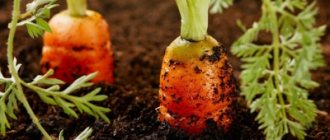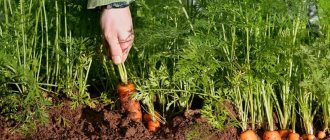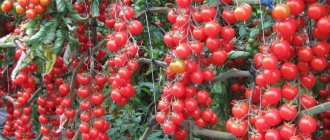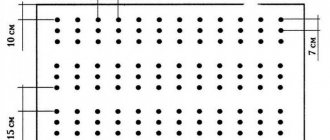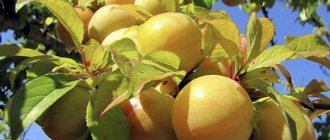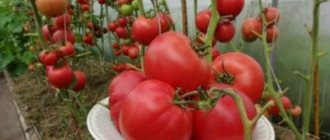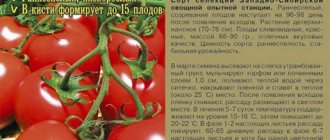The Samson carrot variety is the main sales leader in Russia. Root vegetables of this variety have excellent taste, are stored for a long time and contain a huge amount of useful microelements. Let's find out how to plant these carrots correctly and how to care for them.
Samson carrots grow even and smooth
Samson carrots have good taste, which is why they are one of the best-selling varieties in Russia.
Description and characteristics of Samson carrots
Belongs to mid-early varieties. It takes 4 months from the appearance of the first shoots to harvest. The rosette of leaves is semi-spreading, the foliage is of a rich green hue. Root vegetables when ripe are bright orange, smooth, and have a standard cylindrical shape.
The skin is without tubercles or damage, the tip is slightly rounded. The weight of one root vegetable is about 130 g, reaching 150 g. It is 25 cm in length, but can be 2-3 cm longer.
The skin and flesh are the same color - orange. The core is small in diameter, tightly connected to the pulp, the taste is characteristic of carrots. The root vegetable contains approximately 10% dry matter.
Samson carrots do not crack, are stored for a long time, and can remain in the cellar until the next season.
During ripening, root crops do not rise above the ground level. Seed germination is about 80%, seedlings are not afraid of frost, and can easily survive cold spells down to -4 degrees Celsius.
Samson carrots have strong immunity; they are not afraid of diseases that affect other varieties. The only enemy that Samson can destroy is the carrot fly.
Usage
Root vegetables are ideal for preparing salads and hot dishes. They are also used as an addition to pickles and canned food. You can make carrot juice from root vegetables.
Description
“Samson” belongs to the mid-season varieties: it reaches technical maturity 110-120 days after emergence. It is used for food starting from the stage of bunch (milk) ripeness, which occurs after the 50th day of the growing season.
Plants are powerful, leaf rosette of semi-spreading type. The leaves are medium-dissected, long, green, slightly pubescent. Ripe root crops are located at soil level (the heads do not protrude above the soil surface).
Roots
Root crops are medium and large in size: up to 18-22 cm long, about 4-5 cm in diameter, weighing 120-150 g, with a distinctly rough surface.
The shape of the root crop is cylindrical, with a blunt end, pointed downward. The head is small, smooth, with flat or slightly rounded shoulders. The bark is orange or red-orange. The core is slightly lighter, small (up to 25% of the root diameter), not rough, and fits tightly to the bark. The pulp is strong, juicy, moderately sweet. The taste is good, tasting score is 4-5 points. In terms of the content of useful and nutrient substances, “Samson” is inferior to the already mentioned variety “Nantes 4”:
Root crops of the Samson variety are distinguished by a very even, attractive appearance and high yield of marketable products (more than 90%). The yield per 1 m2 averages 5-8 kg, and the maximum was recorded at 11.3 kg (in 2003 at the Mozyr variety testing station). The purpose of root vegetables is universal: they are used for fresh consumption, industrial and home processing, and storage. Due to the good keeping quality of carrots of this variety, after 6 months of storage, 86.7% of the fruit remains of commercial quality.
The advantages of the Samson carrot variety, according to reviews from vegetable growers, also include:
- endurance in unfavorable weather and soil-climatic conditions;
- frost resistance of seedlings (withstand temperature drops down to −4 ℃);
- intensive fruit filling without cracking or deformation;
- ease of care;
- resistance to cercospora (fungal leaf disease) and flowering.
Flowering (flowering) is a violation of the two-year development cycle of carrots, leading to the appearance of flowering shoots in plants in the first year of growing season. It is more often observed in northern regions, after winter or too early spring sowings, as well as with an excess of nitrogen fertilizers.
Seeds
Seed material of the Samson variety is offered by many foreign and domestic producers. For ease of planting, seeds are released in granulated or pelleted form or placed on special belts.
Sowing of carrot seeds of this variety is carried out in mid-April - early May or in October - November, after the first frosts on the soil (pre-winter). Since high-quality seed material is quite expensive and has a high germination rate (about 80-90%), it is recommended to sow sparingly: with a distance of 2-3 cm between seeds and 15-30 cm between rows. Thinning at such a planting density can be carried out twice: 10-14 days after germination and at the stage of bunch ripeness in July, leaving 5-7 cm between plants to fill the root crops in thickness and form the main crop.
An interesting sowing method that increases the germination of carrot seeds is suggested by a Ural gardener in the following video:
In terms of care, carrots are unpretentious - you can limit yourself to timely watering, weeding and loosening the soil. To obtain maximum yield, intensive fertilizing with complex mineral fertilizers is recommended.
The use of organic matter (fresh manure, chicken droppings) when cultivating carrots leads to undesirable consequences in the form of branching and deformation of root crops, and stimulates excessive growth of green mass of plants.
Advantages and disadvantages
Samson carrots, like other varieties of this crop, have pros and cons; they must be taken into account when growing the plant.
Advantages of this variety:
- high productivity;
- not demanding in terms of care and growing conditions;
- possibility of cultivation throughout Russia;
- during long-term storage, root crops do not begin to rot;
- has a universal purpose.
Disadvantages of the variety:
- not the highest germination rate;
- the likelihood of the formation of ugly root crops;
- Finding seeds for sowing is very difficult.
Maturation period
The variety is characterized by an average ripening period. The first shoots appear after sowing the seeds in 1-2 weeks, technical maturity occurs in 3.5-4 months.
In central Russia, the first harvest can be harvested in mid-summer. By the end of summer, root crops finally reach technical maturity, and they can be used for further storage or processing.
Collection and storage
The first fruits begin to be harvested in July. Full maturity usually occurs in August. Depending on the climate and planting date, the collection time may vary.
Ripe vegetables do not protrude above the surface of the ground, so the head does not turn green. This has a positive effect on the presentation.
After harvesting, cut off the tops of the vegetables and place them in a dark, dry place for a couple of weeks. Afterwards, the dried carrots are sorted out, removing damaged roots. The remaining copies are suitable for long-term storage. They are placed in lattice containers and left in a room with a temperature of 12-14 degrees. The appearance and taste are preserved for a long time, until the next harvest.
Seed production technology
The Dutch company that created this variety is distinguished by high quality products, therefore, before going on sale, the seeds undergo strict cleaning and processing. It consists of calibration, stimulation of germination, treatment against diseases and pests.
The Dutch breeding community sells seeds in different forms:
- ordinary seed with a high degree of purity of the variety;
- calibrated grains with average germination; granulated seeds with a nutritious coating;
- seed with a high content of prophylactic agents, etc.
What kind of selection?
So what are Samson carrots? We will give a description of the variety below. First, let's look at where it came from on the domestic market and what kind of company supplies its seeds. The producer of planting material of this variety is the largest agricultural corporation Bejo Zaden. This Dutch company has branches in many countries around the world. She specializes in seed production and selection. Currently, it employs more than 800 people (200 abroad). Seeds are supplied to markets in different countries by distributors. This manufacturer mainly specializes in the production of carrots, beets and cabbage. The seeds of this company are imported into Russia by, for example, a commercial company.
Landing Features
The Samson variety is unique, the plant gets along in any climate, so you must adhere to the basic rules of agricultural technology, and then you will not have problems with cultivation.
Site selection and soil preparation
A good harvest can only be obtained in illuminated areas with fertile and loose soil.
The plot for carrots is not fertilized with fresh manure.
Prepare the area for carrots in the fall, carefully dig up the soil and apply fertilizer. Pay attention to the acidity of the soil; if the level is elevated, add chalk or lime. You can also use dolomite flour.
Top dressing of soil per 1 sq. m:
- 5 kg of humus or finished compost;
- 2 cups wood ash.
When choosing a place to grow carrots, choose hills, as the plant does not grow well in lowlands with close groundwater. Cultivate heavy soils by adding peat or sawdust. The amount of harvest on clay soils will be minimal, and the risk of deformed roots also increases.
Sowing process
Seeds can be sown both in spring and autumn. The variety is cold-resistant, but still there is no need to plant seed very early. The best indicators for sowing: air temperature +14...+17 degrees Celsius, soil temperature - +5...+9 degrees Celsius.
Samson carrot sowing algorithm:
- In the prepared bed, make holes for sowing, leaving a distance of 20 cm between them.
- Gently pour water into the furrows and sow the seeds. For more convenient sowing, you can mix the grains with sand or chalk.
- Deepen the seed no deeper than 2 cm, sprinkle with earth on top. You can cover the plantings with non-woven material, but this is not necessary. Shelter is only necessary if frosts have not passed in your region, and you want to protect the crop from temperature changes.
- For sowing, choose pelleted grains; they germinate better. You can use the technology of planting seed on paper tapes.
- After 7-10 days, the first shoots appear, and after 2 weeks the carrots begin to spike in even green rows. Covering material is not needed at this stage.
Growing and caring for carrots
Samson carrots require standard care, which consists of loosening the soil, watering the plants, and applying fertilizer.
Watering
Crops need to be irrigated carefully from the moment seedlings emerge. It is unnecessary to add water if it rains or the soil remains wet. As soon as the roots begin to form, increase the amount of watering. Apply only settled and warm water, thoroughly moisten the soil. Stop watering 1-2 weeks before harvest. This simple technique will help the fruits become stronger, crispier and juicier.
You can find more information about proper watering of carrots here.
Loosening and weeding
Loosening must be carried out after watering. This measure will help prevent the formation of a hard crust on the soil surface and will also provide oxygen access to the roots of plants.
After carrots emerge, control the number of weeds. They grow very quickly, and over time they will be able to push carrots out of the area. At first, pull out the weeds so that they do not harm the seedlings. As soon as the carrots gain strength, weeds will not be afraid of them. You need to weed the beds as needed.
If you planted carrots in strips, then the crop does not need thinning. In other cases, this event cannot be avoided; thinning is carried out:
- 1st time - 3 weeks after the formation of the first shoots;
- 2nd time - as soon as the root vegetables have reached 2 cm in diameter.
Don't forget about mulching. It is better to make a soil protective layer from sawdust, peat or humus.
Feeding
Like all other crops, carrots also need fertilizer. During the autumn season, it is customary to feed plants 2-3 times; use nitrophoska or superphosphate. Wood ash is a good alternative; it not only enriches the soil, but also protects against pests and diseases.
Add potassium, it improves the taste of root vegetables and helps carrots last longer in the cellar.
Fertilizers play a special role for vegetables stored in winter. Root crops must be completely protected from rot and various infections. Use special solutions of humates; ready-made mixtures include Kemira, Mortar and Universal.
Apply organic fertilizers after harvesting to restore and saturate the soil.
Pest and disease control
Carrots of this variety are not susceptible to pest attacks. But it is better to take preventive measures. To prevent rot, treat the plantings with Bordeaux mixture, and use traditional methods to fight insects:
- Use herbal infusions for spraying: wormwood + wood ash.
- Dust with tobacco, hot pepper or mustard.
- Plant onions next to the carrots; they repel the main enemy - the carrot fly.
- Plant pelleted seed. In this case, you will not have to thin out the plants, and holes will not appear on the root crops where the carrot fly likes to lay eggs.
- Before planting seeds, treat them in solutions of boric acid, potassium permanganate or hydrogen peroxide.
Use chemicals only in the most urgent cases.
Diseases and prevention measures
Common pathologies that affect carrots of this variety include the following:
- Fomoz is a fungal infection that provokes damage to the stems. As a result, gray-brown spots appear on them. Necrosis makes the stems dry and brittle. From the upper part, pathogens penetrate into the fruit. Pathology poses the greatest danger to carrots grown for seeds. If the disease is not detected in a timely manner, there is a risk of infection of the entire bed. To avoid the development of pathology, it is important to carefully treat carrots with a Fundazol suspension. Phosphorus and potassium fertilizers will also help reduce the likelihood of plantings becoming infected with fungi.
- Black rot is a fungal infection that develops in hot, humid weather. Black rot provokes a decrease in the sugar and keratin content in fruits. As a result, the tops dry out and the fruits turn out small and deformed. The disease remains in the roots and seeds for a long time. It spreads quickly at humidity levels of 85% and temperatures over +20 degrees. To eliminate the problem, the drugs Prosaro and Falcon are used.
- Brown spot - the first symptoms of pathology can be detected on the tops. As a result, the foliage becomes brittle and acquires a dirty brown color. The pathology causes rotting of the fruits.
Important! When root crops are pulled out, essential oils are released, which are loved by the carrot fly and other parasites. To prevent possible pest attacks, it is recommended to sprinkle the garden bed with black pepper or tobacco dust.
To avoid the development of diseases, you should do the following:
- plant carrots in the same place only after 4 years;
- burn infected plants immediately;
- disinfect seeds before planting;
- spray plants with solutions of Epin Extra or Immunocytophot;
- feed crops on time;
- take testes exclusively from healthy crops.
To prevent diseases, the plant requires proper care.
Why do carrots grow ugly?
Carrot roots do not always grow straight and beautiful; there are times when they turn out crooked, small, and branched. The main reasons for the “ugliness” of root crops:
- uneven watering;
- presence of stones in the ground;
- poor quality soil.
If on the path of its growth a root crop encounters a stone, glass or pebbles, it will begin to wrap around the obstacle and grow in an irregular shape. To avoid this, before planting, carefully inspect the area, dig it up and remove unnecessary “obstacles.”
Reviews from gardeners
★★★★★
Tatyana, 46 years old, zoologist, Kirov. Every year I plant Samson carrots; I like them for their good taste.
I use it not only to make various preparations for the winter, but also to make healthy fresh juices. In winter, I store carrots on the balcony in a special box. There are no problems with this, we get root vegetables whenever we want. ★★★★★
Lydia, 67 years old, pensioner, Pskov. Last year I tried to plant this variety of carrots on my plot.
I didn’t regret it, because he made me very happy. The seeds sprouted together, the harvest was harvested in September, there were not a single crooked carrot. It stores well, the taste is excellent, I have no comments about it. The only negative is that it is now very difficult to get seeds, I have already walked around the whole city, they are not available anywhere, only on order. Hide
Add your review
Samson carrots are one of the best crop varieties; its main advantage is the ability to grow in any region of the country. The plant is not afraid of cold weather and sudden frosts, which is very important for gardeners in our country. With proper planting and proper care, it brings rich harvests.
0
0
Copy link

